#Bluetooth SRRC
Text
Find nRF5340 module here!
Find nRF5340 module here!
Where to find nRF5340 module quickly? The nRF5340 a dual core solution deployed with 2 Arm Cortex M33 processors. Not only provide faster and powerful for advanced applications, but also LE audio. Raytac knows your anxiety and already distributed the modules available in several channels aimed to provide a speedy and comfortable way to get it.
Buy From Amazon
MDBT53-1M ModuleMDBT53-P1M…

View On WordPress
#amazon#BLE#bluetooth#BT5.2#BT5.3#CE#digi-key#FCC#IC#LE Audio#MDBT53#MDBT53V#Module#Nordic#nRF53#nRF5340#Raytac#RCM#SRRC#Telec
0 notes
Text
6 Tips to Reduce the Risks of Hardware Entrepreneurship

In this case, you probably need to start from scratch: go deep into the market, understand the demand, and run through the supply chain.
Judging from my personal HE Tuber actual product experience: if you do not have a unique advantage or do not have matching resources in the market, the probability of failure is extremely high.
No matter how perfect the product is, no matter how sure you are that you will be a huge success.
You should always strive to minimize risk.
Of course, you can't completely eliminate risk.
But risks can be minimized, investments protected and chances of success increased.
The odds are generally better for hardware startups.
As a start-up, you need to build every possible advantage to help you achieve your financial goals.
Here are six ways you can gain a competitive advantage when bringing new hardware products to market to reduce risk and increase your chances of success.
Hire multiple independent engineers
When it comes to developing electronic hardware products, one of the best ways to reduce risk and increase your chances of success is to hire at least two engineers:
An engineer comes to actually develop the electronics;
Another independent engineer comes to review the design;
Then prototypes are produced.
No matter how good an engineer is, mistakes are almost always made when designing anything complex.
You should always strive to gather as much feedback as possible.
Design reviews are key to preventing mistakes. One thing is certain:
Any hardware product developed by a large company is reviewed by multiple engineers.
For startups, if you have the ability to review.
This will undoubtedly save a lot of personnel costs and be more efficient.
Start with small batches
Your first priority is to get your product to market as quickly as possible and as cheaply as possible.
while minimizing risk.
Risk is something you should focus on before your product achieves significant sales success.
Take the smart lock product that I was personally responsible for as an example. At that time, market verification had been initially completed.
Then they started to build assembly plants and made a lot of investment in mass production, and the capital chain was almost broken.
That is, if you go bankrupt before getting your product to market.
Then there is no point in focusing on maximizing profits.
Use electronic modules
One of the best ways to reduce electronics complexity, and therefore risk, is to use proven electronic modules for certain functions.
For example, if your product requires wireless functionality, you will need to obtain a radio certification license from your region or country.
Certification usually takes a long time, and some also charge certification fees.
For example, in China you need to obtain radio certification SRRC.
For example, when I personally used Bluetooth and WiFi when making products in the early days, I needed to undergo SRRC certification at this time.
At the beginning, because I was not clear about the specific testing standards, I spent about a month and visited the certification agency three times.
Electronic modules are independent components designed to perform specific functions and are electronic circuits that are easily integrated into other products.
For example, some networking modules of Tuya and Espressif.
Of course, the reality is that most products still require some custom circuit design.
This is because using modules entirely to make products will greatly increase the unit cost.
Secondly, if your product is very small.
For example, in wearable technology, the module size may be too large, making it impossible to use modules for design.
Make full use of manufacturer resources
Most manufacturers have some resources that include assistance with design, engineering, 3D modeling, and prototyping during the product development process.
They may also connect you with suppliers, such as component and packaging suppliers.
If you have a viable product and maintain consistent sales.
They can also provide you with billing terms, such as allowing you to pay within 30 to 90 days after shipment, etc.
This will greatly improve your cash flow and increase your competitiveness.
When you work with a manufacturer, they generally allow for amortization of tooling costs.
Build a customer base before building a product
You need market feedback from day one.
Don’t wait until your product is ready to hit the market before you start thinking about how to sell it.
You need to gain some market traction as quickly as possible.
Hardware startups face serious challenges, and you can reduce risk and increase your chances of success by exploring these strategies.
This has two benefits:
First, you will be able to get quick market feedback from potential future customers;
Secondly, once your product is available for sale, there will be a large number of customers ready to buy your product.
Pre-sell your products
People may praise your product.
But all the praise means nothing unless it's accompanied by sales.
You need to pre-sell your product and test it in the market.
Getting feedback quickly can let you know whether the product has value and whether it's worth spending more of your resources.
0 notes
Link
0 notes
Text
Bluetooth headset to do SRRC certification
Bluetooth headset to do SRRC certification
The SRRC certification is a must for any Bluetooth headset that wants to be sold in China. But what exactly is this certification, and why is it so important? In this blog post, we'll explore the SRRC certification process and what it means for Bluetooth headsets. We'll also provide some tips on how to make sure your headset is SRRC-certified. By the end of this post, you'll know everything you need to about SRRC certification for your Bluetooth headset.
What is the mark of SRRC certification?
SRRC certification is a compulsory certificate for products that use the 2.4GHz band in China. The full name is "2.4GHz Short-Range Radio Transmission Equipment Certification". In order to obtain SRRC certification, manufacturers need to apply to radio management authorities and testing organizations recognized by the Ministry of Industry and Information Technology for testing and certification and pass the test to obtain a certificate.
The mark of SRRC certification is a logo with the letters "SRRC" in it. This logo must be displayed on the product or packaging, as well as in any promotional or marketing materials for the product.
Products that have obtained SRRC certification are allowed to be sold in China.
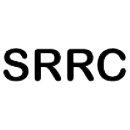
The necessity of applying for SRRC certification
The SRRC (Short-Range Radio Communications) certification is a must for any Bluetooth headset that is to be used in China. The certification, which is granted by the China Ministry of Industry and Information Technology, ensures that the device meets certain safety and quality standards.
Not only is the SRRC certification a requirement for import into China, but it is also necessary for the sale of any Bluetooth headset within the country. This makes sense when you consider that most people use their Bluetooth devices in close proximity to their heads and face, and thus potential health risks are involved.
So if you're looking to buy or sell a Bluetooth headset in China, make sure that it has been certified by the SRRC. It's the only way to be sure that you're getting a safe and high-quality product.
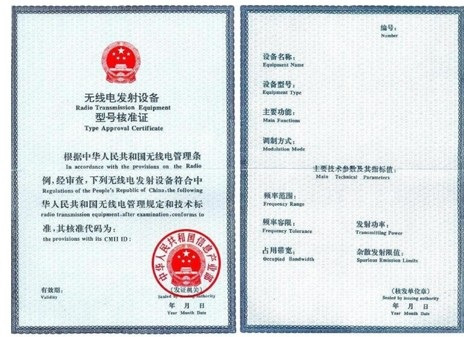
SRRC Certification Application Procedures
In order to obtain SRRC certification for your Bluetooth headset, you will need to submit a certification application to the appropriate authorities. The application must include all relevant documentation and fees as required by the SRRC. Once your application has been reviewed and approved, you will be issued a certificate which will allow you to sell your product in China.
ZHONGREN is a professional ccc certification china, we provide you with one-stop service throughout the process and escort the success of your product certification because we have established a good relationship with Chinese certification bodies and testing laboratories. Our team provides high-quality certification services for customers. It can make the whole authentication process go smoothly. Even if the client obtains the CCC/SRRC/NAL/CEL certificate after the initial certification, we will continue to provide regular audit services, certificate changes, etc.
0 notes
Text
Deeplight Technology Bluetooth protocol SRRC certification services
Let’s see why there is a radio transmission equipment type approval certification\SRRC certification. Background: According to the "Regulations of the People's Republic of China on Radio Management"(Regulations of the People's Republic of China on Radio Management), in order to strengthen radio management, maintain the order of air waves, effectively develop and utilize radio spectrum resources, and ensure various radio services.
The Regulation shall be observed in the use of radio frequencies, the establishment and use of radio stations (stations), the R&D, production, import, sale and maintenance of radio transmitting equipment.
All radio transmission equipment produced in the territory of the People’s Republic of China must hold the "Radio Transmission Equipment Type Approval"certificate issued by the State Radio Regulation Committee (SRRC) after the type approval.The type approval code CMIIT ID must be marked on the label of the equipment.
Annexes :
1. Radio Transmission Equipment Type Approval Certificate
(sample)
2. Application Form for Radio Transmission Equipment Type Approval (sample)
3. Application Form for the Importation of Mechanical and
Electrical Products (sample)
4. Certificate for the Importation of Mechanical and Electrical
Products (sample)
5. Registration Form for the Importation of Mechanical and
Electrical Products (sample)
6. Declaration Form for Customs Entry of Radio Equipment
(sample)
7. Ratification Statement for Customs Entry of Radio Equipment (sample)
For any radio transmission equipment that are exported to China, the foreign businessman involved should possess a “ Radio Transmission Equipment Type Approval Certificate ” ( see Annex 1) issued by the Office of State Radio Regulatory Commission of the People’s Republic of China ( hereinafter referred to as SRRC Office ) and a Type Approval Identifier( hereinafter referred to as SRRC ID ) should be marked on the equipment.
Application SRRC need to prepare the information
1 application form (two copies)
2 power of attorney (two copies)
3 customer's business license (license Business)
4 the customer's ISO certificate or company profile and the company's ability to explain
5 the circuit diagram of the product, instruction manuals, block diagrams, related test reports (such as ID FCC)
6 antenna gain (Peak Gain Antenna) and pattern Antenna
7 test instruction (direction Test)
8 the company's business license (annual inspection can not be expired)
9 EUT color photos 3 copies (must contain the various interfaces and the side)
10 frequency channel control table (if there are a lot of work channels to provide, such as DSSS or FHSS working mode of the product)
Deeplight Technology specially arranges professional RF engineers to directly connect with SRRC let you save time and effort, one-stop finish SRRC certificate.
Email: [email protected] WeChat:dlcert
Mobile:+86-18038042309 Tel:+86-755-8920 2795
0 notes
Photo

New Post has been published on https://www.updatedc.com/2019/01/08/dji-smart-controller-for-the-mavic-2-pro-and-mavic-2-zoom/
DJI Smart Controller for the Mavic 2 Pro and Mavic 2 Zoom
The DJI Smart Controller for the Mavic 2 Pro and Mavic 2 Zoom drones has been announced at CES. The Smart Controller features an ultra-bright display screen and optimized controls and allows users to fly the Mavic Pro 2 and Mavic Zoom without using a smartphone or tablet.
DJI Smart Controller
The DJI Smart Controller features a 5.5” screen built into the controller itself. It has been designed so that you no longer need to connect to a mobile device. This makes the whole process of getting your drone up in the air a lot quicker and easier. It can be paired with DJI’s newest drones including Mavic 2 Zoom and Mavic 2 Pro which use DJI’s OcuSync 2.0 video transmission system. The DJI Smart Controller supports automatic switching between 2.4 GHz and 5.8 GHz, reducing the influence of environmental interference on drone operation and image quality. This also ensures reliable long-range transmission at distances of up to 8 km.
Users can take advantage of its compact, highly portable design that has been optimized for use in direct sunlight. The ultra-bright display has an output of 1000 cd/m2, twice the brightness of standard smartphones. The brightness can be manually and automatically adjusted. When Auto mode is enabled, the DJI Smart Controller will automatically adjust its brightness using a built-in light sensor, making it optimal for the human eye according to the surrounding environment.
The DJI Smart Controller comes with a built-in microphone and speaker for expanded options such as live streaming. It can also playback video through the HDMI port at 4K 60fps with H.264 and H.265.
A customizable Android dashboard supports DJI GO 4, DJI Pilot, along with various third-party apps such as editing programs. The DJI GO 4 app also touts several new features including SkyTalk, that allows pilots to live stream the drone’s camera feed to social channels including Facebook, Instagram, and WeChat.
Another new feature is DJI GO-Share which easily transfers imagery from the Controller to your mobile device. The DJI Smart Controller brings a new level of reliability when flying, with 2.5 hours of battery life and the ability to operate in adverse temperatures as cold as -4°Fahrenheit and as hot as 104°Fahrenheit.
What is interesting is that users can download third-party apps through the built-in browser or install APK files from a microSD card. (DJI will not be liable for any permission or safety issues resulting from the use of third-party apps. If an installed third-party app prevents you from enjoying optimal use of your controller, DJI suggests you remove the app or restore the controller to the original factory settings.)
Price and Availability
The new Smart Controller will be available for purchase beginning in early 2019 for the retail price of $649 USD. Combination packages of the Smart Controller with Mavic 2 Pro and Mavic 2 Zoom will be available as well.
Is it worth the high asking price?
The Smart Controller looks to be a great idea, but to me, it seems extremely pricey given the fact it is going to cost almost half the price of a Mavic Pro 2 or Mavic 2 Zoom. What do you think? Let us know in the comments section below.
Specifications
DJI Smart Controller
OcuSync 2.0
Operation Frequency Range
2.400-2.4835 GHz, 5.725-5.850 GHz[1]
Max Transmission Distance (unobstructed, free of interference)
2.400-2.4835 GHz:
8 km (FCC), 4 km (CE), 4 km (SRRC), 4 km (MIC)
5.725-5.850 GHz:
8 km (FCC), 2 km (CE), 5 km (SRRC)
Transmitter Power (EIRP)
2.400-2.4835 GHz:
25.5 dBm (FCC), 18.5 dBm (CE), 19 dBm (SRRC), 18.5 dBm (MIC)
5.725-5.850 GHz:
25.5 dBm (FCC), 12.5 dBm (CE), 18.5 dBm (SRRC)
Wi-Fi Protocol
Wi-Fi Direct, Wireless Display, 802.11a/g/n/ac, Wi-Fi with 2×2 MIMO is supported
Operation Frequency Range
2.400-2.4835 GHz, 5.150-5.250 GHz
5.725-5.850 GHz
Transmitter Power (EIRP)
2.400-2.4835 GHz:
21.5 dBm (FCC), 18.5 dBm (CE)
18.5 dBm (SRRC), 20.5 dBm (MIC)
5.150-5.250 GHz:
19 dBm (FCC), 19 dBm (CE)
19 dBm (SRRC), 19 dBm (MIC)
5.725-5.850 GHz:
21 dBm (FCC), 13 dBm (CE), 21 dBm (SRRC)
Bluetooth Protocol
Bluetooth 4.2
Operation Frequency Range
2.400-2.4835 GHz
Transmitter Power (EIRP)
4 dBm (FCC), 4 dBm (CE), 4 dBm (SRRC), 4 dBm (MIC)
Battery
18650 Li-ion (5000 mAh @ 7.2 V)
Charge Type
Supports USB power adapters rated 12 V/2 A
Rated Power
15 W
Storage Capacity
ROM 16 GB + scalable (microSD)
Charging Time
2 hours (using a USB power adapter rated 12 V/2 A)
Working Time
2.5 hours
Video Output Port
HDMI Port
Power Supply Current / Voltage (USB-A port)
5 V/ 900 mA
Operation Temperature Range
-4° to 104° F (-20° to 40° C)
Storage Temperature Range
<1 month: -22° to 140° F (-30° to 60° C)
1-3 months: -22° to 113° F (-30° to 45° C)
3-6 months: -22° to 95° F (-30° to 35° C)
>6 months: -22° to 77° F (-30° to 25° C)
Charging Temperature Range
41° to 104° F (5° to 40° C)
Supported Aircraft Models
Mavic 2 Pro, Mavic 2 Zoom
GNSS
GPS+GLONASS
Weight
Approx. 630 g
Supported SD cards
microSD™
Supports microSD cards with a capacity of up to 128 GB and R/W speed up to UHS-I Speed Grade 3
0 notes
Text
ESP32-DevKitC WIFI & BLE module
ESP32-DevKitC is an ESP-WROOM-32 wireless module that combines wifi and Bluetooth Low Energy (BLE) networks in one compact board. This module uses wifi 802.11 b / g / n network protocol working on 2.4 GHz frequency and bluetooth v4.2 technology that has supported EDR and BR features. In addition to this module also has an internal USB-to-UART converter, so you can directly program this module with a computer through a micro USB port that is available, without the need to add an external USB-to-UART converter.
Specification:
- Supports WiFi connectivity, Bluetooth Classic, and BLE
- Comes with an internal USB-to-UART converter (CP2102)
- Using Sox-based Tensilica Xtensa 32-bit LX6 @ 240 MHz
- Supports wireless networking protocol 802.11 b / g / n @ 2.4 GHz
- Compliance with FCC-US, CE-EU, IC-CA, TELEC-JP, SRRC and KCC-KR certification
- Equipped 520 Kb SRAM and 448 Kb ROM
- Able to run FREERTOS, UCOSII
- Has a small dimension that is only 25.2 mm x 18 mm
http://ift.tt/2qlZwJa
May 16, 2017 at 08:38AM
0 notes
Link
0 notes
Text
Raytac nRF53 Module BT5.2 Qualified, FCC/IC/CE/Telec/KC Pre-Certified.
The nRF5340 is the world’s first wireless SoC with two Arm® Cortex®-M33 processors. The architecture is including an “Application Processor” which deployed a 1M Flash 512K RAM; and a “Network Processor’ which deployed a 256K Flash and 64K RAM. With the IoT applications has become more and more complex nowadays, nRF5340 is exact the solution to meet higher specification demand of technology and…

View On WordPress
#BLE#bluetooth#BT5.2#CE#FCC#IC#KC#MDBT53#MDBT53V#MIC#Module#NCC#Nordic#nRF53#nRF5340#Raytac#SRRC#Telec
0 notes
Text
Raytac Released nRF52833 Module / MDBT50Q Series
Raytac Released nRF52833 Module / MDBT50Q Series
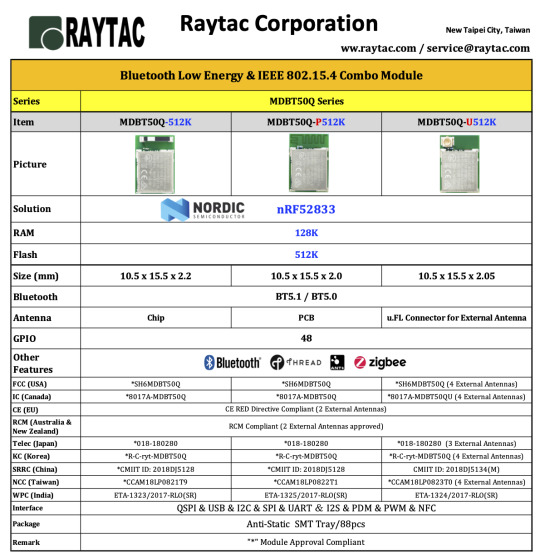
Nordic’s nRF52833 is an advanced mulitiprotocol SoC solution which supporting not only Bluetooth mesh, Thread, Zigbee but also latest BT5.1 direction finding capable radio. The solution is built around 64MHz Arm Cortex-M4 FPU, 512KB flash memory, and 128KB RAM memory with an extended industrial standard working temperature range of -40 °C to 105°C which is an ideal solution for commercial and…
View On WordPress
#bluetooth#BT5.1#CE#FCC#IC#MDBT50Q#Module#NCC#Nordic#nRF52833#Raytac#RCM#SRRC#Telec#Thread#WPC#Zigbee
0 notes
Text
Welcome nRF52805 & nRF52820 module on board
Welcome nRF52805 & nRF52820 module on board
It figures, Raytac launched nRF52820 & nRF52805 modules soon after Nordic released the SoC. As usual, all modules by Raytac are Bluetooth qualified and regulation pre-certified by FCC/IC/CE/SRRC/Telec/KC/SRRC/NCC.
With both modules added on the list, whole nRF52 series module road map now has become comprehensive and completed.

#nRF52805 SolutionMDBT42T series designed for highly cost…
View On WordPress
0 notes
Text
Just right at the start of 2020, we are happy to announce nRF52833 modules are now available!
Raytac’s nRF52833 series modules are introduced in 3 kinds of antenna options (Chip Ceramic / PCB / u.FL connector for external antenna) brings the best usability to meet different implements.
Chip Antenna Version: MDBT50Q-512K
PCB Antenna Version: MDBT50Q-P512K
u.FL Connector Version: MDBT50Q-U512K
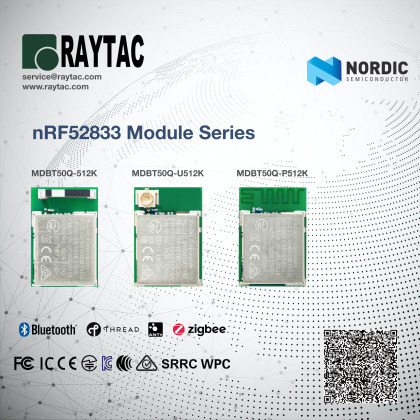
Raytac’s nRF52833 MDBT50Q Series modules, supports Bluetooth, Thread, ANT+, and Zigbee multi-protocol solution and BT5.1 direction finding capable radio. All modules are BT5.1 & BT5 Bluetooth qualified and FCC/IC/CE/Telec/KC/RCM/NCC/SRRC/WPC pre-certified, which are the optimized solution that makes it attractive in a very wide range of applications from a performance, time-to-market efficiency, and minimal Bill of Material (BOM) perspective.
Not only modules are in mass production, Raytac also released the module demo board (aka, Eval Board Kit) at the same time. The demo board, MDBT50Q-DB-33, deployed Raytac’s nRF52833 module “MDBT50Q-512K” which is the best tool for developers’s to proceed the developing works.
Some developers may pursue nRF52833 from nRF52840 due to cost effective reason. Raytac would like to remind those developers that nR52833 and nRF52840 are NOT drop in compatible but may need to have some hardware/firmware modification to transfer the project.
For those developers are encouraged to visit our article to learn more about
Change to nRF52833 module? What the Hardware & Firmware Setting Need To Review?
Would like to know more of our nRF52833 modules? Raytac would like invite all developers to contact us or distributors for more information.
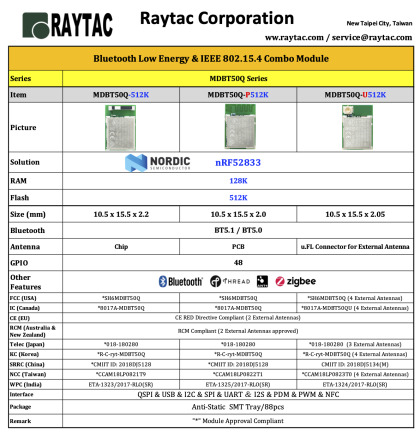
Raytac Corporation 勁達國際電子有限公司
A BT5.1 & BT5 & BT 4.2 module maker based on Nordic nRF52 & nRF51 solution
(nRF52840 & nRF52833 & nRF52832 & nRF52810 & nRF52811 & nRF51822)
www.raytac.com email: [email protected] Tel: +886.2.3234.0208
Raytac nRF52833 Series Module MDBT50Q & Demo Board Now Are Available Just right at the start of 2020, we are happy to announce nRF52833 modules are now available!
#ANT#bluetooth#BT5#BT5.1#CE#FCC#IC#KC#MDBT50Q#Module#Nordic#nRF52833#nRF52840#Raytac#RCM#Telec#Thread#Zigbee
0 notes
Text
MDBT50Q-RX, a nRF52840 USB Dongle, delivers an easy implement for M2M IoT application
MDBT50Q-RX, a nRF52840 USB Dongle, delivers an easy implement for M2M IoT application
Raytac’s BT5 certified nRF52840 USB dongle, MDBT50Q-RX, eliminating the need for RF design expertise, and speeding time to market for complex M2M IoT applications. The Dongle built by Raytac’s MDBT50Q-P1M module with FCC/IC/CE/Telec/KC/SRRC/NCC/RCM/WPC certification.
Raytac’s MDBT50Q-RX, a Nordic nRF52840 USB Dongle
(more…)
View On WordPress
#BLE#bluetooth#Bluetooth 5#BT5#CE#Dongle#FCC#IC#IOT#KC#MDBT50Q-RX#Module#NCC#Nordic#nRF52840#Raytac#RCM#SRRC#Telec#WPC
0 notes
Text
Raytac BT5 MDBT50Q-U External Antenna Type Module (Nordic nRF52840 Solution) Now Is Available
Raytac BT5 MDBT50Q-U External Antenna Type Module (Nordic nRF52840 Solution) Now Is Available
Bluetooth 5 grabs the attention may drop in “Long Range Feature”!
Compare to BT4.X BLE module in the market, mostly reach only about 20~30M.
Even Raytac’s BT4.X series modules, the best performance may about 100~140M line of sight.
Recent released MDBT50Q series, deploy Nordic nRF52840 has dramatically break the barrier of connectivity rage.
Upon the test under 1M bps / sending data and link…
View On WordPress
#bluetooth#BQB#BT5#CE#External Antenna#FCC#IC#IOT#KC#long range#MDBT50Q#MDBT50Q-U#Module#Nordic#nRF52840#Raytac#RCM#SRRC#Telec
0 notes
Text
為什麼要選用勁達(Raytac)的藍牙模組?
市面上可以選用的藍牙模組甚多, 常有客戶問我們
“為什麼要選用勁達的模組?“
尺寸, 功能表現, 安規費用, 成本
1. 尺寸:
勁達的藍牙模組是市面上相對較小尺寸的模組模塊, 且模組系列的選擇性多, 可以幫助研發工程人員輕易選用尺寸適合的產品建置在產品當中, 不需要因為受限於模組尺寸的困擾而必須修改產品的外觀設計
2. 功能表現:
勁達的藍牙模組是以Nordic nRF51及nRF52的方案為基礎, 因此除了是ARM Cotex M0或M4的MCU, 且內建16K或32K RAM 及256K或512K flash memory 方便研發工程人員可以設計韌體, 運算演算法
此外, OTA (Over The Air)的DFU (Device Firmware Update)的功能更可以方便更新韌體,…
View On WordPress
#BLE#Bluetooth#BT4.0#BT4.1#BT4.2#BT5#CE#藍芽#FCC#IC#KC#MDBT40#MDBT42#Module#Nordic#nRF51#nRF52#Raytac#SRRC#Telec
0 notes
Text
MDBT42 (Nordic nRF52832方案)安規���成取證
依據勁達國際電子產品開發政策, 所有模組都必須完成安規取證, 以利客戶使用
MDBT42系列模組(Nordic nRF52832方案)今日已完成主要國家的安規取證
藍牙BT4.2證書(請點我)
FCC (USA美國): SH6MDBT42 IC (Canada加拿大): 8017A-MDBT42 Telec (Japan日本): 201-170035 …
View On WordPress
0 notes